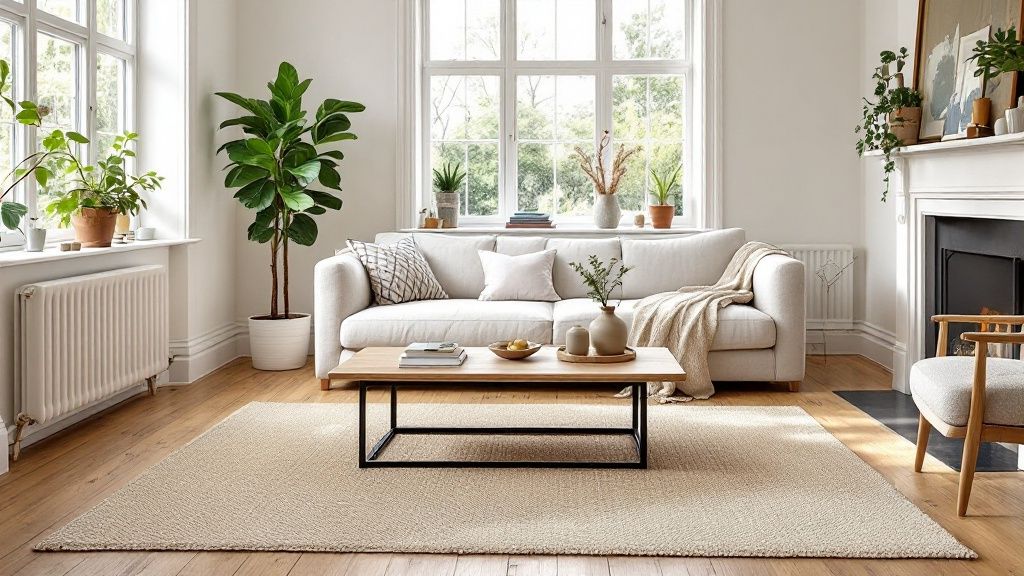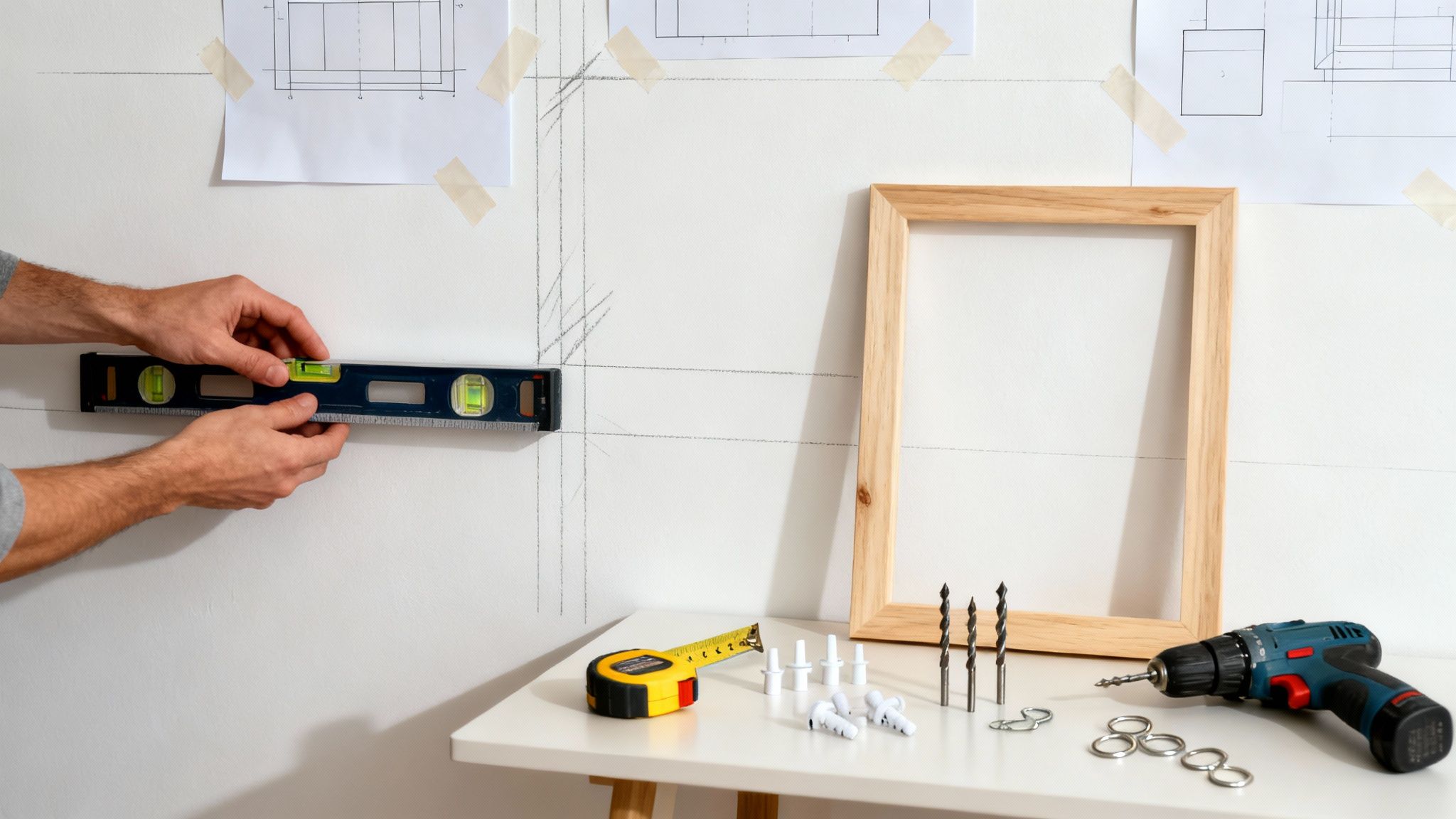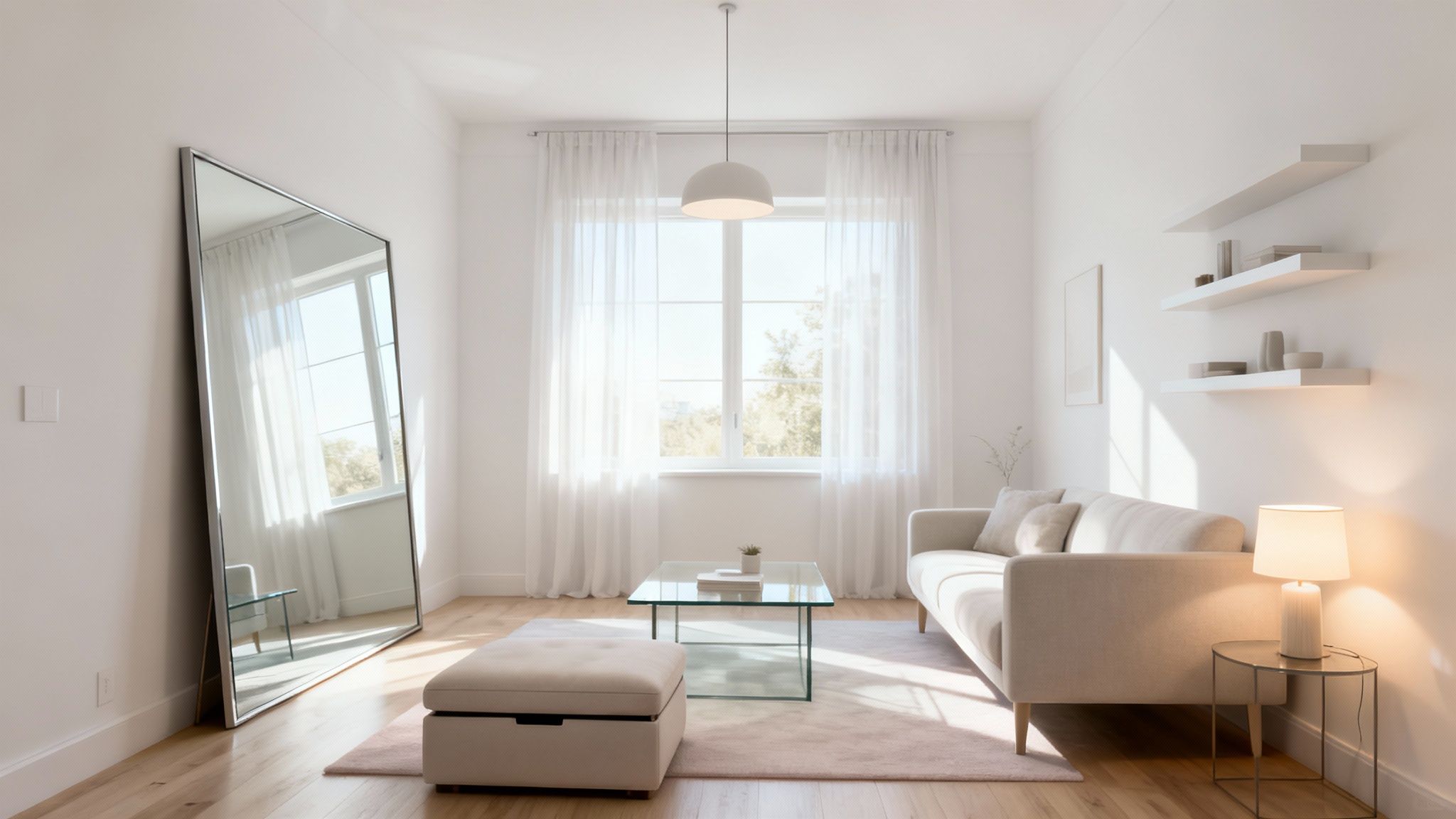Staring at a bare floor or a less-than-inspiring carpet? You’re not alone. The interior design secret you might be missing is layering rugs – it's a fantastic way to instantly inject character and solve some common decorating headaches in UK homes. This isn't about following stuffy design rules; it's a wonderfully practical way to bring your personality into a room, mixing textures and patterns to get that curated, finished look.
Why Layering Rugs Is a Game-Changer for Your Home
Thinking of layering rugs as just another fleeting trend would be a mistake. It's actually a seriously smart design strategy that pays off in both looks and practicality. It's the perfect fix for adding visual depth and a real sense of warmth, especially on those chilly hardwood or tiled floors that are so common. By playing with different textures, you can make a room feel so much more inviting.
It’s also an incredibly versatile trick. Got a big open-plan living area? A well-placed layered rug combo can cleverly carve out different zones, like a cosy seating nook or a dedicated dining space, without putting up a single wall. It’s such an effective way to bring a little order to your layout and help guide how people move through the room.
Add Warmth and Define Your Space
Beyond just looking great, there are some real functional wins here. An extra layer underfoot naturally helps with sound absorption, which can make your rooms feel quieter and more peaceful. It's also a brilliant solution for hiding a tired or stained carpet, giving the space a whole new lease of life without the cost and hassle of a full replacement. A smaller, plush rug on top can completely change the feel of a room, giving you a soft spot to land your feet. For more ideas, have a look at our guide on how to make a room cosy and inviting.
The real beauty of layering is that it lets you get creative and avoid being locked into one single design. You can finally show off that smaller, more precious patterned rug by placing it over a larger, neutral base. This instantly creates a focal point that draws the eye and pulls the room's whole colour scheme together.
This technique has really taken hold in UK interior design, mainly because of how well it adds that much-needed texture and warmth. A popular starting point is a large, durable base rug made from a natural fibre like jute. Then, you can add a smaller accent rug on top for a pop of pattern or a bit of plushness. It’s a method that not only makes things more comfortable but also protects your main carpet or floor from everyday wear and tear.
Choosing Your Foundation Rug
The success of your entire layered rug look really hinges on getting the foundation right. Think of this base rug as the anchor for your room – it’s the piece that grounds all your furniture and truly sets the stage. If you get this part wrong, the whole effect can feel a bit accidental and thrown together.
The goal is to pick a large, usually neutral, rug that acts as a solid canvas for the more expressive rug you'll place on top.
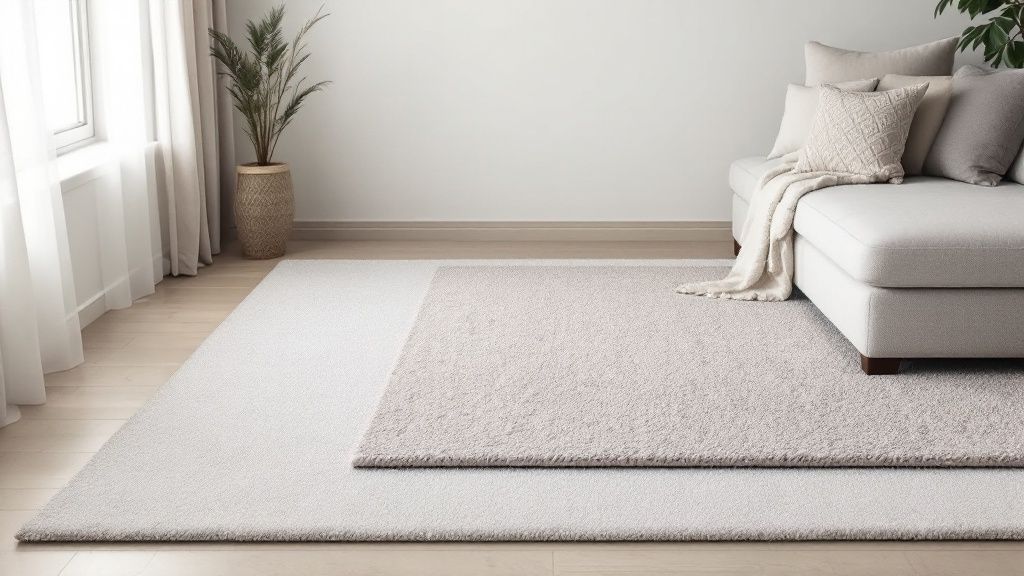
Essentially, this base layer should feel like the background of a beautiful painting, not the main event. Its primary job is to define the space and offer a subtle texture that complements, rather than competes with, the top rug.
Selecting the Right Material
When you're choosing your foundation, durability and a low profile are absolutely key. You need a rug that can stand up to daily life and sits flat on the floor without creating too much bulk.
Here are a few of my go-to options:
- Jute and Sisal: These natural-fibre rugs are brilliant for base layers. They bring a fantastic texture to the room, are incredibly hard-wearing, and their neutral, earthy tones provide a versatile backdrop for almost any style.
- Low-Pile Wool: A flatweave or low-pile wool rug is another superb choice. Wool is naturally durable and soft underfoot, giving a slightly more refined feel than jute or sisal.
It's interesting to see how trends affect these choices. The UK rug market has grown a lot, with wool holding a significant market share because of its sustainability and warmth. This often means people use an affordable tufted base with a more luxurious wool rug on top, blending practicality with a touch of style.
Expert Tip: Getting the size right is non-negotiable for the foundation rug. The most common mistake I see is a rug that's too small, which instantly makes a room feel cramped and poorly planned. Your base rug should be large enough for at least the front legs of your main furniture pieces to rest comfortably on it.
Sizing Your Foundation Rug
So, what does that look like in practice?
In a living room, it means the rug should extend underneath your sofa and any armchairs, properly grounding the entire seating area. For a dining room, you need to ensure it’s large enough for the chairs to be pulled out from the table without their back legs catching on the edge.
Making a confident choice here is one of the key principles of affordable interior design. A well-sized foundation rug makes the whole space feel cohesive and thoughtfully put together, creating the perfect base for you to add your next layer.
Pairing Textures and Patterns with Confidence
This is where the real fun begins and your personal style can truly shine. Pairing different textures and patterns is what takes layered rugs from simply functional to genuinely fabulous. The secret lies in creating a thoughtful contrast that looks intentional and stylish, rather than accidental or chaotic.
Think about the feeling you get when you combine different materials. A flat, natural-fibre base like jute or sisal provides a fantastic, earthy foundation. Now, imagine placing something incredibly soft on top, like a plush, high-pile rug or a luxurious faux sheepskin. That tactile difference is irresistible and adds real depth to the room.
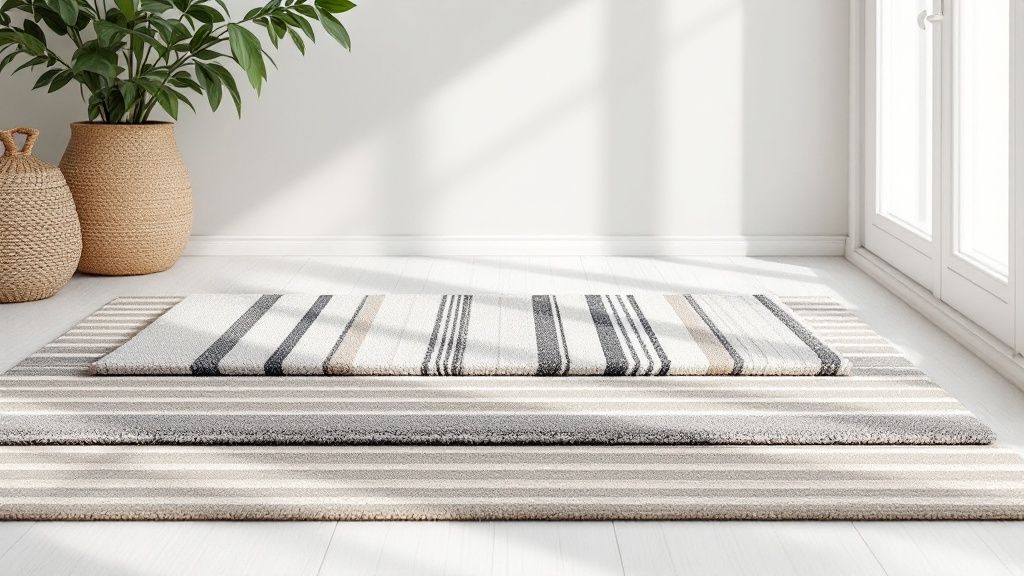
This kind of textural play is becoming a hallmark of modern UK homes, bringing visual warmth and a curated, designer feel to any space. We're seeing a real shift towards handwoven, artisan pieces made from organic fibres. If you're looking for more inspiration on blending these styles, have a look at our guide on choosing the right colours for your living room.
Mastering Pattern Combinations
When you start mixing patterns, things can feel a bit tricky, but there’s a simple rule of thumb that makes it easy. If your top rug is the star of the show – say, a vibrant Kilim or a vintage Persian-style piece – then the base rug needs to be its quiet, supportive co-star. Opt for a solid colour or a very subtle, large-scale pattern underneath to prevent the two from clashing.
A great guideline is the 80/20 rule: let one rug make up the majority of the visual statement (with a bold pattern or texture), while the other provides a more subtle supporting role. This is your key to achieving balance and avoiding a cluttered look.
For instance, a busy, small-scale geometric pattern on your top rug will look stunning laid over a simple, neutral jute base. On the other hand, if you have a bold, wide-striped base rug, you could pair it with a solid-coloured, high-pile top rug to soften the look.
This approach is popping up everywhere in current UK interior design. Recent surveys show that a majority of homeowners see a rug as essential for completing a living space, and layering is a fantastic way to make a unique artistic statement.
To help you get started, here's a quick guide to some classic pairings that always work well.
Rug Texture and Pattern Pairing Guide
This table offers a few tried-and-tested combinations to give you confidence when mixing and matching your rugs.
Remember, these are just starting points. The best part about layering is that it’s a chance to experiment and find a combination that feels completely you.
Arranging Layered Rugs in Any Room
You’ve found your perfect rug pairing – brilliant. Now for the fun part: bringing the look to life in your home. The real trick to getting layered rugs right is understanding that placement isn't a one-size-fits-all deal. What looks fantastic in a big, open-plan living room could feel all wrong in a cosy bedroom or a narrow hallway.
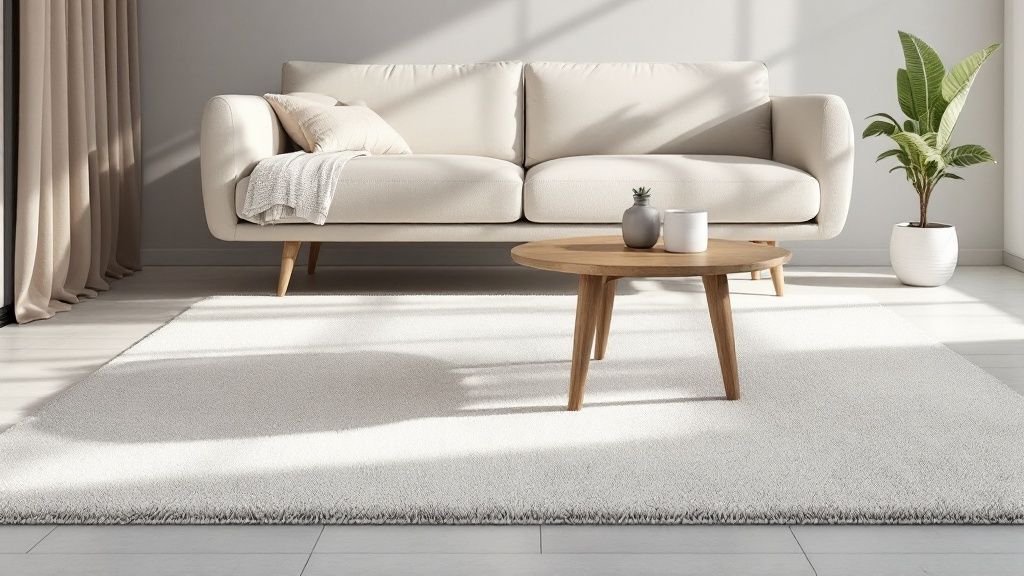
Let's walk through some room-specific tips I’ve picked up over the years to make sure your layered look is both beautiful and practical.
The Living Room Arrangement
In a living room, your rugs should create a clear, unified seating area. Think of the base rug as the foundation. It needs to be large enough for at least the front legs of your sofa and any armchairs to sit comfortably on it. This single move grounds the entire arrangement.
Once that’s in place, the smaller top rug becomes your centrepiece. A classic approach is to place it right under the coffee table, which really anchors the whole conversation zone. This technique is fantastic for pulling all the furniture together, making the room feel more connected and inviting. If you're working with a smaller footprint, our guide on small living room layout ideas has some great pointers.
I often see top rugs "floating" in the middle of a room, not touching any furniture. It looks a bit lost. A quick fix is to tuck just the edge of the top rug under the front of your sofa. This small adjustment makes the whole setup feel much more deliberate and pulled together.
Bedroom and Dining Room Placement
For the bedroom, comfort is everything. You want a soft, warm spot for your feet to land on a chilly morning. Instead of automatically centring the top rug, try an off-kilter placement. Laying it partially under one side of the bed or just at the foot of the bed adds a touch of casual, lived-in style while giving you that plush surface right where you need it.
Dining rooms, on the other hand, are all about function. Chairs need to move easily without catching on a rug's edge. This means both rugs must be large enough for the dining chairs to stay on them completely, even when pulled out. Symmetrical placement is almost always the best bet here; an off-centre top rug can make the whole dining set look unbalanced.
And don't overlook your hallways! Layering runners can inject so much personality into what's often a forgotten space. Try placing a smaller, colourful runner over a simple, hard-wearing jute or sisal base. It creates a beautiful pathway that draws you into the home.
Common Layering Mistakes to Avoid
Layering rugs is a brilliant way to add depth and personality to your home, but I’ve seen a few common slip-ups that can take a look from stylish to slightly strange. Knowing what to watch out for is half the battle. After all, even the most beautiful rugs can look awkward if they aren’t paired thoughtfully.
One of the most frequent errors I see is choosing two rugs that are too similar in size. This creates a tiny, flimsy-looking border that feels more like a mistake than a confident design choice. You want to frame the top rug, not just give it a skinny little outline.
Another classic blunder is clashing patterns. While mixing designs is definitely part of the fun, pairing two busy, small-scale patterns can create visual chaos. It just makes the space feel cluttered, with the patterns fighting for attention rather than complementing each other.
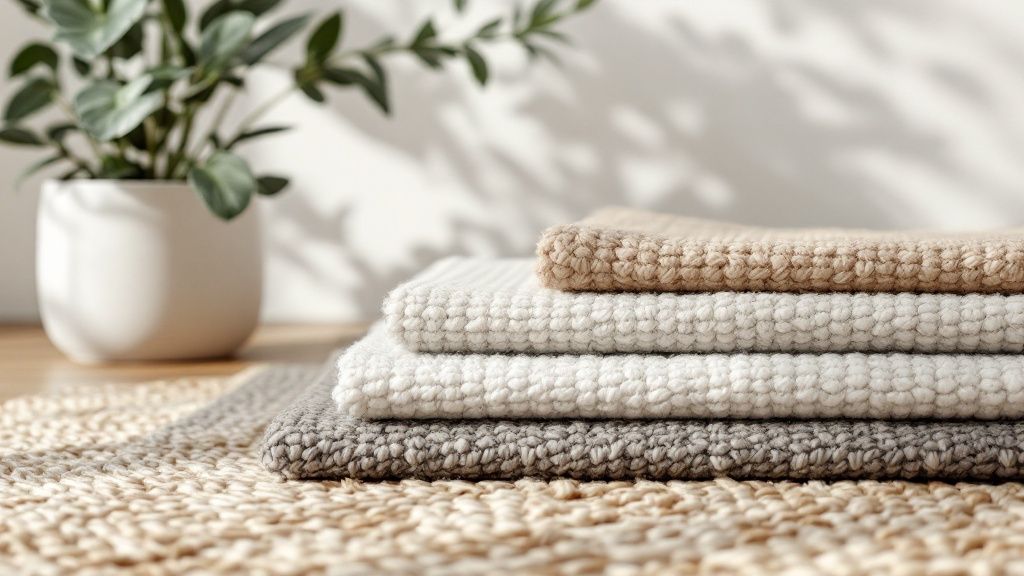
Getting Proportions and Scale Right
Scale is, without a doubt, the most crucial element to get right. A small top rug floating on a huge base can look lost and insignificant, and it can actually shrink the feel of the entire room. On the flip side, a base rug that's too small for the furniture it's meant to ground will make the whole arrangement feel disjointed and messy.
A key takeaway: A great rule of thumb is to aim for the top rug to be roughly two-thirds the size of the base rug. This proportion creates a generous, balanced border of about 30-45 cm on each side, which always looks intentional and polished.
To sidestep these common issues, here’s what I always recommend:
- Vary Your Sizes Significantly: Don't be timid here. You need a clear, obvious difference in size between your layers to make it work.
- Balance Your Patterns: Let one rug be the hero. Pair a bold, statement pattern with a solid colour or a subtly textured base.
- Ground Your Furniture: This one is non-negotiable for a cohesive look. Always make sure your base rug is large enough to sit under at least the front legs of your main furniture pieces, like your sofa and armchairs.
Finally, remember that a poorly chosen combination can really affect the room's atmosphere, sometimes even making a bright space feel darker. If you're struggling with that, our tips on how to brighten a dark room can offer some valuable solutions. Layering rugs with confidence really just comes down to a little thoughtful planning.
Still Wondering About Layering Rugs?
Even after getting the hang of the basics, a few questions often pop up when you're actually trying to layer rugs in your own space. Let's tackle some of the most common ones I hear.
Can You Really Layer a Rug on Top of a Carpet?
Yes, absolutely! Placing a rug over a wall-to-wall carpet is one of my favourite tricks. It's a fantastic way to carve out a distinct zone, like a reading nook in a bedroom, or to inject some much-needed colour and pattern into a neutrally carpeted room. It’s also a clever fix for hiding stubborn stains or worn spots.
The key is to work with a low-pile carpet as your base to ensure everything stays stable. Then, go for a top rug with a completely different feel – a flatweave kilim or even a faux cowhide can look stunning. Just remember to use a quality non-slip rug pad underneath your top rug; it’s essential to prevent it from creeping and bunching up.
How Much of the Bottom Rug Should I Let Peek Through?
Getting the proportions right is what separates a designer look from a random pile of rugs. I always recommend leaving at least 30-45 cm (about 12-18 inches) of the base rug showing on all sides. If you’re working with a really spacious room, you can push that out to 60 cm (24 inches) for a bolder statement.
Think of the bottom rug as a frame for the one on top. This border is what makes the whole setup look deliberate and polished. If the border is too narrow, the top rug can look like it's floating aimlessly rather than being anchored.
The secret is in the frame. That visible border is what turns two separate rugs into a single, cohesive design element.
What Are the Best Rug Materials for This?
For your base layer, you want something sturdy and relatively flat. Natural fibres like jute and sisal are a go-to choice; their earthy texture is the perfect visual anchor, and they're built to last. A tightly woven, low-pile wool rug also makes for an excellent, solid foundation.
The top layer is where you can have all the fun and bring in personality and comfort. This is your chance to add a touch of luxury. Some great options include:
- A plush, high-pile wool rug for that sink-your-toes-in feeling.
- A faux sheepskin or a shag rug for maximum softness and drama.
- A vibrant, patterned kilim or a vintage Persian-style rug to introduce colour and history.
What matters most is the contrast. The difference in texture between the two layers is what creates that rich, dynamic look that makes layered rugs so appealing.

